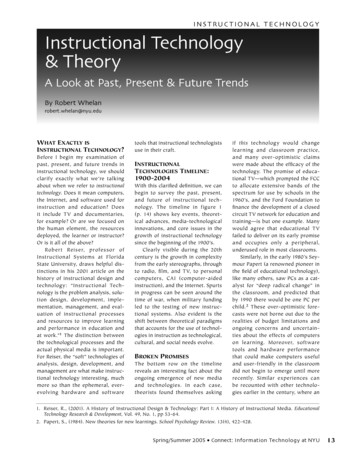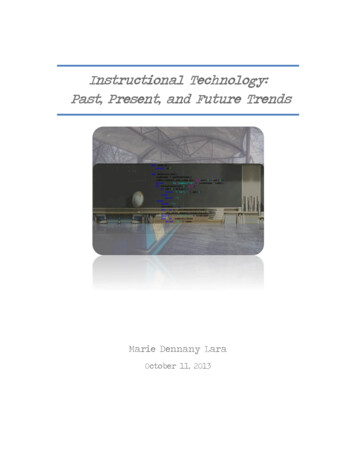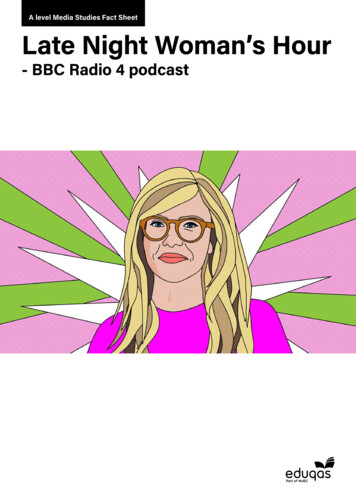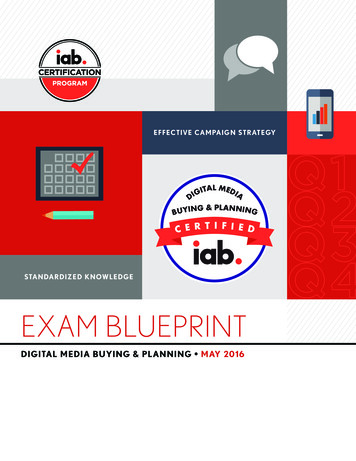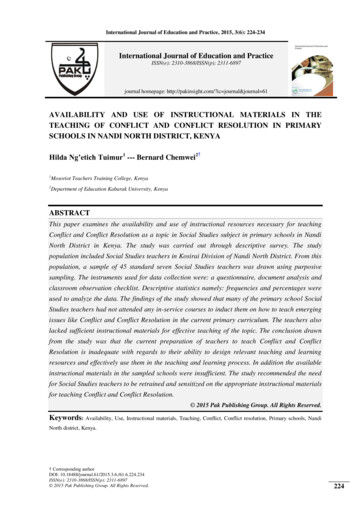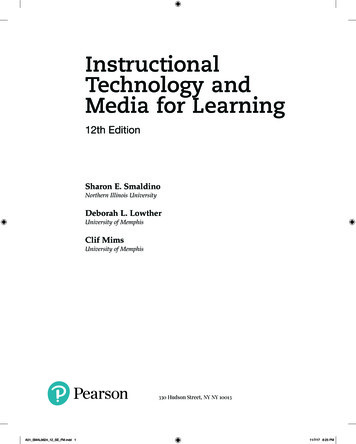
Transcription
InstructionalTechnology andMedia for Learning12th EditionSharon E. SmaldinoNorthern Illinois UniversityDeborah L. LowtherUniversity of MemphisClif MimsUniversity of Memphis330 Hudson Street, NY NY 10013A01 SMAL9624 12 SE FM.indd 111/7/17 8:25 PM
Editorial Director: Kevin DavisPortfolio Manager: Drew BennettManaging Content Producer: Megan MoffoSenior Content Editor: Max Effenson ChuckContent Producer: Yagnesh JaniPortfolio Management Assistant: Maria FelibertyDigital Development Editor: Carolyn SchweitzerSenior Digital Producer: Allison LongleyExecutive Product Marketing Manager: Christopher BarryExecutive Field Marketing Manager: Krista ClarkProcurement Specialist: Deidra SmithCover Design: Studio MontageCover Art: ShutterstockEditorial Production and Composition Services: SPi GlobalFull-Service Project Manager: Heather Winter, SPi GlobalPrinter/Binder: RR DonnelleyCover Printer: Phoenix ColorText Font: Palatino LT Pro 9.5/13Acknowledgments of third party content appear on the approriate page within the textPEARSON, ALWAYS LEARNING, and MYLAB are exclusive trademarks in the United States and/or other countries ownedby Pearson Education, Inc., or its affiliates.Unless otherwise indicated herein, any third-party trademarks that may appear in this work are the property of their respectiveowners and any references to third-party trademarks, logos, or other trade dress are for demonstrative or descriptive purposesonly. Such references are not intended to imply any sponsorship, endorsement, authorization, or promotion of Pearson’sproducts by the owners of such marks, or any relationship between the owner and Pearson Education, Inc., or its affiliates,authors, licensees, or distributors.Copyright 2019, 2015, 2012, 2009 by Pearson Education, Inc. All Rights Reserved. Printed in the United States of America.This publication is protected by copyright, and permission should be obtained from the publisher prior to any prohibitedreproduction, storage in a retrieval system, or transmission in any form or by any means, electronic, mechanical, photocopying,recording, or otherwise. For information regarding permissions, request forms and the appropriate contacts within the PearsonEducation Global Rights & Permissions Department, please visit www.pearsoned.com/permissions/.Library of Congress Cataloging-in-Publication DataNames: Smaldino, Sharon E., author. Lowther, Deborah L., author. Mims,Clif, 1971- author. Russell, James D., author.Title: Instructional technology and media for learning / Sharon E.Smaldino, Northern Illinois University, Deborah L. Lowther, University of Memphis,Clif Mims, University of Memphis, James D. Russell, Purdue University.Description: Twelfth Edition. Boston : Pearson Education, Inc., [2018] Includes bibliographical references and index.Identifiers: LCCN 2017015584 ISBN 9780134287485 ISBN 0134287487Subjects: LCSH: Educational technology. Audio-visual education.Classification: LCC LB1028.3 .H45 2018 DDC 371.33—dc23LC record available at https://lccn.loc.gov/201701558410 9 8 7 6 5 4 3 2 1—DOC—17 16 15 14ISBN 10: 0-13-428748-7ISBN 13: 978-0-13-428748-5A01 SMAL9624 12 SE FM.indd 211/7/17 8:25 PM
Brief Contents1Exploring Student Learning 2Designing Instruction and Assessing Learning 213Integrating Technology and Media into Instruction:The ASSURE Model 394Designing Digital Learning Environments 655Engaging Learners with Digital Devices 956Connecting Learners Using Web 2.0 1187Teaching at a Distance 1398Enhancing Learning with Multimedia 1689Preparing for Tomorrow’s Challenges 209Appendix Lesson Scenarios 1231Glossary 232References 237Name Index 241Subject Index 243Credits 250iiiA01 SMAL9624 12 SE FM.indd 311/7/17 8:25 PM
A01 SMAL9624 12 SE FM.indd 411/7/17 8:25 PM
ContentsAbout the Authors ixPreface xi1Exploring Student Learning Framework for Academic and Career Learning:Technology and Media in Today’s Schools Instructional Technology 122Technology for All Learners: Using TechnologyTools to Differentiate Instruction 4Instructional Materials Roles of Technology and Media in Learning 67The Digital Teacher Digital Instruction Technology Standards for Teachers Video Example 1.1: How Do You Choose theRight Web Tools? National/State Curriculum Standards The Digital Learner Digital Tools Digital Communication with Others 7891010111112Video Example 1.2: Wiki Discussion 12Technology Guidelines for Students Technology for Inclusion Response to Intervention Universal Design 13131314Framework for Academic and Career LearningLiteracies 14Student Outcomes 14Support Systems 14Effective Learning Environments The Learning Continuum: Traditional to Digital The Changing Role of Media Centers 151516Copyright Concerns: Copyright Law Educators and Copyright Law Fair Use Seeking Permission to Use Copyrighted Materials Term of Protection Changing the Material’s Format 161717171818Summary 19Professional Development 19Suggested Resources 202Designing Instruction andAssessing Learning Learning Theories Behaviorist Perspective Cognitivist Perspective A01 SMAL9624 12 SE FM.indd 521222222Constructivist Perspective 23Video Example 2.1: Constructivism 23Social-Psychological Perspective 24Principles of Effective Instruction for Learners Information and Instruction Bloom’s Digital Taxonomy and The “Four Cs” 242526Taking a Look at Technology Integration: The NewTech Network 28Multiple Intelligences Meeting Learner Needs 2829Principles of Effective Technology Use 29Video Example 2.2: Media Literacy Skills 30Principles of Effective Media Use 31Video Example 2.3: Using Online Resources 31Principles of Effective Learning Assessment Authentic Assessment Portfolio Assessment 323234Technology Resources: Rubrics 36Traditional Assessment 37Summary 37Professional Development 38Suggested Resources 383Integrating Technology andMedia into Instruction:The ASSURE Model ASSURE Classroom Case Study 3940The ASSURE Model 40ASSURE A Model to Help Assure Learning 41Analyze Learners 41General Characteristics Specific Entry Competencies Learning Differences and Needs 414242ASSURE Classroom Case Study: Analyze Learners 43Video Example 3.1: Analyze Learners 43State Standards and Objectives Importance of Standards and Objectives The ABCDs of Well-Stated Learning Objectives ABCD Objectives Checklist Learning Objectives and Individual Differences 4444454647ASSURE Classroom Case Study: State Standardsand Objectives 48Select Strategies and Resources Select Strategies Select Resources Selecting, Modifying, or Designing Materials 48484949v11/7/17 8:25 PM
vi ContentsASSURE Classroom Case Study: Select Strategiesand Resources 51Video Example 3.2: Select Strategies and Resources 51Utilize Resources Preview Resources Prepare Resources Prepare the Environment Prepare the Learners 5252525252ASSURE Classroom Case Study: Utilize Resources 53Video Example 3.3: Utilize Resources 53Provide the Learning Experience 54Drill and Practice: Integration of Technologyand Media Tutorials: Integration of Technology and Media Discussions: Integration of Technology and Media Problem-Based Learning: Integration ofTechnology and Media Video Example 4.2: Integrating WebQuests 7676777778Cooperative Learning: Integration of Technologyand Media 78Gaming: Integration of Technology and Media 78Taking a Look at Technology Integration:Cooperative Learning 79Require Learner Participation 54Practice 54Selection RubricASSURE Classroom Case Study: Require LearnerParticipation 56When to Use Learning Strategies 82Learning Contexts in Today’s Classrooms Face-to-Face Instruction 8383Video Example 4.3: Face-to-Face Learning Context 85Video Example 3.4: Require Learner Participation 56Feedback 56Evaluate and Revise Evaluate Impact on Student Learning Evaluate and Revise Strategies and Resources Revision of Strategies and Resources 57575758ASSURE Classroom Case Study: Evaluate and Revise 60Video Example 3.5: Evaluate and Revise 60Summary 61ASSURE Lesson Plan Template: Analyze Learners 62Professional Development Suggested Resources 62634Designing Digital LearningEnvironments ASSURE Classroom Case Study Distance Learning Blended Instruction Structured Independent Study Nonstructured Informal Study 8285868787Integrating Free and Inexpensive Materials Advantages of Free and Inexpensive Materials Limitations of Free and Inexpensive Materials Integration of Free and Inexpensive Materials 87888888Sources for Free and Inexpensive Materials Obtaining Free and Inexpensive Materials Evaluating Free and Inexpensive Materials 89909065Summary 916871Cooperative Learning 71Gaming 72Simulations 73Discovery 74Integration of Technology and Media intoLearning Strategies 75Presentations: Integration of Technology and Media 75Demonstrations: Integration of Technology andMedia 76A01 SMAL9624 12 SE FM.indd 6Discovery: Integration of Technology and Media 80Innovations in Teaching: Interactive MultitouchDesks 90Tutorials 69Discussions 69Problem-Based Learning 70Video Example 4.1: Problem-Based Learning Games and Simulations 7965Types of Learning Strategies 66Presentations 66Demonstrations 67Drill-and-Practice 68Technology for All Learners: EnglishLanguage Learners Simulations: Integration of Technology and Media ASSURE Lesson Plan 91Professional Development Suggested Resources 93945Engaging Learners withDigital Devices 95ASSURE Classroom Case Study 96Using Digital Devices in the Classroom 96Video Example 5.1: Planning Digital Lessons 97Desktop to Mobile Continuum Strategies and Approaches 9798Copyright Concerns: Software 98Types of Digital Resources 99Video Example 5.2: Preparing Students toCreate Digital Presentations 101Advantages of Using Digital Devices 102Limitations of Using Digital Devices 10311/7/17 8:25 PM
Contentsvii103ASSURE Lesson Plan 135Taking a Look at Technology Integration: Testingthe Waters 104Professional Development Suggested Resources 137138When to Use Technology 104Application Selection 105Technology for All Learners: Software and Apps 105Selection Rubric106Integrating Technology for Learning Software Hardware 108The Digital Classroom Single-Device Classroom Multi-Device Classroom 110110111Video Example 5.3: Multiple Device Classroom 113Innovations in Teaching: Digital Fabricator: A Printerfor Real Objects 113Summary 1147Teaching at a Distance 139ASSURE Classroom Case Study 139Designing Learning at a Distance 140Video Example 7.1: Blackboard Design 141Student Access to Resource Materials 142Copyright Concerns: Distance Learning 142Teaching at a Distance Strategies and Approaches Types of Technology Resources 143143144Video Example 7.2: Online Academic Discussion 145ASSURE Lesson Plan 115Video Example 7.3: Video Discussion 146Professional Development Suggested Resources 117117Video Example 7.4: Video Class 1486Critical Issues 148Advantages of Distance Learning Connecting LearnersUsing Web 2.0 118ASSURE Classroom Case Study 118Web 2.0 Functions 119Collaborative Contributions 119Social Networking 119Mashups 120Integrating Web 2.0 Resources into Instruction 120Video Example 6.1: Students Learning toUse Web 2.0 120Blogs 121Wikis 121Video Example 6.2: Integrating Web 2.0 Productivity Apps Taking a Look at Technology Integration:Productivity App 122123150Limitations of Distance Learning 151Copyright Concerns: Online Learning 152Integrating Distance Resources into Learning Virtual Public Schools Connecting with Text Integrating WebQuests 152153153153Taking a Look at Technology Integration:Key Pals 154Taking a Look at Technology Integration:Extending Knowledge through WebQuests 155Connecting with Computer Conferencing Connecting with Parents Connecting with Other Teachers Connecting with Communities Course Connections 155155155156156124Taking a Look at Technology Integration: GLOBE:Networking Students, Teachers, and Scientists Social Bookmarking Multimedia Sharing 124125Technology for All Learners: Distance LearningResources 157When to Use Web 2.0 125Video Example 7.5: Blackboard Benefit 157130Network Resources Types of Networks The World Wide Web Evaluating Online Resources 158158159160Advantages of Using Web 2.0 for Instruction 132Technology Resources: Search Engines for Kids 160Technology for All Learners: Web 2.0 Tools 132Selection Rubric161Limitations of Using Web 2.0 for Instruction 133Video Example 6.3: Issues of Web 2.0 Use 133Social Networks 127Mashups 128Selecting Web 2.0 Resources 129Selection RubricWeb 2.0 Resources Innovations on the Horizon: Semantic-AwareApplications 134Summary 134A01 SMAL9624 12 SE FM.indd 7Online Resources Innovations in Teaching: Mobile Learning 156163Summary 163ASSURE Lesson Plan 164Professional Development Suggested Resources 16516611/7/17 8:25 PM
viii Contents8Enhancing Learning withMultimedia 168ASSURE Classroom Case Study 168Incorporating Multimedia Literacies intoTeaching 169Enhancing Learning with Audio Advantages of Audio Limitations of Audio When to Integrate Audio into Instruction 170170171171When to Use Audio 172How to Integrate Audio into Instruction Technology for All Learners: Audio Selection of Audio Resources Types of Digital Audio Selection RubricAudio Resources Producing Audio 172173174174175177Copyright Concerns: Audio—Music 177Video Example 8.1: Audio in Learning 178Enhancing Learning with Video Advantages of Video Limitations of Video Integration of Video 178179179180Technology for All Learners: Adapting Video 181When to Use Video 181Types of Educational Videos Taking a Look at Technology Integration: Video Selection of Video Resources Selection RubricVideo Resources Producing Video 181182182183185Selection of Visual Materials Types of Visuals Selection Rubric194194Visual Resources 195Technology for All Learners: Visuals 197Producing Visuals Capturing Digital Visuals 199202Copyright Concerns: Visuals 202Video Example 8.4: Visuals in Learning 203Innovations in Teaching: The Maker Movement 203Summary 204ASSURE Lesson Plan 204Professional Development Suggested Resources 2062079Preparing for Tomorrow’sChallenges 209The ASSURE Model for Tomorrow’s Learning 210Video Example 9.1: Digital Conversion 210Tomorrow’s Thinking and Learning Tomorrow’s Models Tomorrow’s Learning Environments 211211213Tomorrow’s Teachers 218Video Example 9.2: Capturing Learningwith ePortfolios 218Exemplify Digital Age Thinking Ubiquitously Integrate Emerging Technologies Support Global Collaboration 218219219Future Ready Professional Learning Professional Engagement 220220Video Example 9.3: ProfessionalDevelopment and Online Communities 221Copyright Concerns: Video 186Video Example 8.2: Video in Learning 186Enhancing Learning with Text Advantages of Text Limitations of Text Integration of Text Types of Text Resources 187187187188188Technology for All Learners: Text 189Summary 228Professional Development 228Suggested Resources 229189189Appendix Lesson Scenarios 190Glossary 232Video Example 8.3: Text in Learning 192References 237Enhancing Learning with Visuals 192Name Index 241Subject Index 243Selection of Text Resources Producing Text Selection RubricText Resources Advantages of Visuals Limitations of Visuals Integration of Visuals A01 SMAL9624 12 SE FM.indd 8192193193Professional Organizations Professional Journals Funding Technology for Tomorrow Types of Grants Writing a Grant Proposal 221223224225226231Credits 25011/7/17 8:25 PM
About the AuthorsSharon E. SmaldinoSharon served for many years as a speech therapist and special educator in schooldistricts from Florida to M innesota. She spent many years working with PK-12 ageddeaf and hearing-impaired students in public schools and in residential programs.For several years she worked with hearing impaired students who were placedin a residential program for social and emotional issues. During the time she wasworking with those students Sharon began a doctoral program at Southern Illinois University-Carbondale with a focus on instructional design and technology integration. Sharon brought her personal computer into her classroom to help her deaf students explore new technology-integrated learning experiences. Following completionof her degree, Sharon started her career as a teacher educator where she focused onworking with teacher candidates, faculty, and PK-12 teachers to integrate technologyinto the learning process. Presenting at state, national, and international conferences,Sharon has become an important voice on applications of technology in the classroomand in distance education. In addition to her teaching, Sharon has written articles forstate and national journals, chapters, and books on her primary research interest—effective technology integration in learning. She has worked on the developmentand implementation of grants that are designed to support teachers to integrate technology into their teaching. Sharon has received several awards for her teaching and professional activities. She has served as a journal editor and has held leadership positions in several state and national professional associations.Deborah L. LowtherDeborah has been an educator for over 30 years. For the first seven years of her careershe taught middle school science and was highly engaged with providing professionaldevelopment to teachers within and beyond her district. Because of her desire to workwith teachers, she received her PhD in educational technology in 1994 and accepted afaculty position at the University of Memphis in 1995. At the University of Memphis,Deborah served as Department Chair for Instruction and Curriculum Leadership (ICL).The ICL department offers eight initial teacher licensure programs as well as severalMS and EdD options. Prior to accepting the chair positon, Deborah served as the seniortechnology researcher for the Center for Research in Educational Policy, through whichshe researched PK-12 technology integration issues. She has personally conductedobservations in PK-12 classrooms and interviewed students, teachers, and principalsin numerous schools across the country. She has used the knowledge and experiencesgained through engagement in applied research to develop the iNtegrating Technologyfor inquiry (NTeQ) Model with Dr. Gary Morrison. This model has been the foundational approach for several high-profile state-level technology initiatives. With regardto scholarship, Deborah has coauthored several books, chapters, and refereed journalarticles; presented at numerous national and international conferences; and providedprofessional development to educational institutions across the nation.Clif MimsClif is a teacher, researcher, author, speaker, and educational consultant specializing inthe effective integration of technology with teaching and learning. His teaching careerbegan more than 20 years ago as an elementary and middle school teacher. He alsocoached basketball and math teams to numerous championships. While earning hisA01 SMAL9624 12 SE FM.indd 9ix11/7/17 8:25 PM
x About the Authorsdoctorate in instructional technology at the University of Georgia, Clif began focusingon teacher education and professional development. He is a professor of instructionaldesign and technology at the University of Memphis and is the founding executivedirection of the Martin Institute for Teaching Excellence. Clif is both a Project ZeroFaculty Fellow and a Future of Learning Fellow at Harvard University. He and hiswife have three children.A01 SMAL9624 12 SE FM.indd 1011/7/17 8:25 PM
PrefaceAbout This BookInstructional Technology and Media for Learning, Twelfth Edition, shows how a completerange of technology and media formats can be integrated into classroom instruction using the ASSURE model for lesson planning. Written from the viewpoint of theteacher, the text shows specifically and realistically how technology and media fit intothe daily life of the classroom. This book is intended for educators at all levels whoplace a high value on learning. Its purpose is to help educators incorporate technologyand media into their repertoire—to use them as teaching tools and to guide studentsin using them as learning tools. We draw examples from elementary and secondaryeducation because we know that instructors in these PK–12 settings have found previous editions of this book useful in their work.New to This EditionThis edition is necessitated by the amazing pace of innovation in all aspects of technology, particularly in those related to computers and mobile technologies, as well asthe Internet. The text has been updated to reflect the accelerating trend toward technology advances and changes in educational use of technology resources. We havecombined two former chapters, audio and video, to reflect the multimedia conceptsrelevant today. The twelfth edition also addresses the interaction among the roles ofteachers, technology coordinators, and school media specialists, all complementaryand interdependent teams within the school. The explanation of the ASSURE model has been revised to be more clear, practical, andfocused on PK–12 teaching and learning. Several chapters include ASSURE ClassroomCase Study features that show how teachers can effectively integrate technology andmedia into instruction to augment their students’ learning experiences. The chapters have been revised with updated information about designing instruction for learning that focuses on current learning standards and learning environments. Every effort has been made to identify the most current technology to support learning, providing an overview of how to use the technologies with studentsof all ages. We’ve included end-of-chapter professional development activities thatguide the user through teacher performance assessment using technology standards as part of the process. We have updated several of the Taking a Look at Technology Integration features withexamples of how actual classroom teachers use technology to support studentlearning. The examples place emphasis on integrating the learning standards andlearner-centered instructional strategies. We have focused on enhancing the use of technology to meet the learning needs ofall students in a classroom. With the increase in student diversity, classroom teachers are expected to meet the learning needs of all s tudents. We have expanded theTechnology for All Learners feature to help consider options that will be useful tofacilitate learning experiences for all students in the classroom. We have added self-check items throughout each chapter to give the reader opportunities to recall the material just read and make connections to learning experiences. The reader can respond to questions that help them check for understanding.These replace the former e nd-of-chapter demonstration of professional knowledgeexercises that were in previous editions.xiA01 SMAL9624 12 SE FM.indd 1111/7/17 8:25 PM
xii PrefaceKey Content Updates by ChapterSpecific chapter-by-chapter updates and additions include the following: Chapter 1: The first chapter reflects an extended discussion of academic and careerlearning experiences with updates on media and technology integration in classrooms. It includes an overview of effective learning environments. Key componentsof copyright issues are presented. Video segments offer ideas from the classroom.An updated description of the use of media and technology in instruction is present. An overview of assessment options is provided. Questions and discussionoptions are embedded throughout the chapter to provide learners with opportunities to explore the topics. Chapter 2: The chapter provides an updated overview of learning theories andprinciples of effective instruction. Video examples provide examples of ways thatthe technology offers support for learning and the embedded questions provideways for learners to explore their thinking. Chapter 3: The foundational components of the ASSURE model have been updatedand further supported with targeted, short video examples of actual classroom practice. The video examples demonstrate each step of the model and offer higher-levelquestions to deepen the learning experience. Chapter 4: Expanded discussion of digital learning environments explores a variety of learning strategies and contexts from a teacher’s perspective. New examples,tips, and ideas reflect current classroom use of technology and media. Chapter 5: This chapter has been updated to align with digital devices used intoday’s classrooms to enhance learning. Video examples are revised to better demonstrate use of technology in classrooms. We embed new and thought-provokingquestions and interactive application exercises throughout to keep readers engagedand increase learning. Chapter 6: This chapter has been revised to demonstrate the expanded roleof Web 2.0 and social media in today’s schools. New terminology aligns withcurrent apps and digital devices used to support learning. The video examplesprovide insight into the ideas explored within the chapter. The embedded questions provide ways to engage the learners as they read the chapter. Chapter 7: An updated description of planning and implementing instruction ata distance is presented. An overview of resources to enhance learning opportunities in distance settings is included. Video of classroom use of distance learningprovides examples within the chapter and, along with the embedded questionsand discussion points, serves to guide the reader towards understanding the topics. Chapter 8 (formerly chapters 8 and 9): Chapters are combined, with integratedmaterial covering four types of multimedia used to enhance learning: audio, video,text, and visuals. Integration examples are updated to illustrate ways new technologies and media are used in the classroom. Selection Rubrics for each type of mediaare embedded for quick access. Chapter 9 (formerly chapter 10): The Preparing for Tomorrow’s Challenges chapter is fully updated with new Learning Outcomes, exciting video examples, andcutting-edge practices emerging on the horizon. Among the new topics are: coding as literacy, transdisciplinary learning, artificial intelligence, and augmentedreality. The chapter also provides a new discussion of future ready professionaldevelopment.Pearson REVEL REVEL is Pearson’s newest way of delivering our respected content. Fully digitaland highly engaging, REVEL offers an immersive learning experience designed forA01 SMAL9624 12 SE FM.indd 1211/7/17 8:25 PM
Prefacexiiithe way today’s students read, think, and learn. Enlivening course content with mediainteractives and assessments, REVEL empowers educators to increase engagementwith the course to better connect with students.REVEL Offers:Dynamic content matched to the way today’s students read, think, and learn,including: Integrated Videos and Interactive Media Integrated within the narrative, videosempower students to engage with concepts and take an active role in learning.REVEL’s unique presentation of media as an intrinsic part of course content bringsthe hallmark features of Pearson’s bestselling titles to life. Video examples within ASSURE Case Study boxes offer students the opportunity to see key technologies at work, putting the ASSURE model into practicein different classrooms throughout the text. Application Exercises are interactive activities that allow students to test theirunderstanding of skills and concepts throughout each chapter, using formativeand summative assessment tools. These include fill-in-the blank, drag-and-droptables, and journal exercises.Interactive Check Your Understanding items are multiple choice assessmentquestions that test students’ knowledge of the content they have just read at theend of each major section. Feedback for the correct answer is provided.Interactive Shared Writing activities allow students to answer questions andshare their responses with others. Interactive Glossary The material links bolded key terms in the text to glossarydefinitions, enabling students to read and comprehend with clarity without skipping concepts they do not understand.Our ApproachWe share a number of convictions that underlie this edition. First, we believe in aneclectic approach to instruction. Advocates cite an abundance of theories and philosophies in support of different approaches to instruction—behaviorist, cognitivist, constructivist, and social-psychological. We view these theoretical positions as differingperspectives— different vantage points—from which to examine the complex world ofteaching and learning. We value each of them and feel that each is reflected in theguidance we offer.Second, we have a balanced posture regarding the role of technology in instruction. Because of this perspective, we consider each technology in light of its advantages, limitations, and range of applications. No technology can be described solely asbeing either “good” or “bad,” so we strive to give a balanced treatment to a range oftechnologies and media resources.Third, we believe that technology can best be integrated into instruction whenviewed from a learner’s perspective. Therefore, throughout the book we attempt toapproach technology and media solutions in terms of a teacher’s day-to-day challenges and to avoid technical jargon as much as possible. Our examples deal witheveryday teaching issues in a range of content areas.The ASSURE Model for Technology IntegrationTo ensure our approach is applied effectively, we created the ASSURE Model for planning that included considerations for technology integration. This model presents aprocedure that helps teachers consider appropriate technology that aligns with content standards while meeting the learning needs of all of their students. We have further refined this model in this current edition.A01 SMAL9624 12 SE FM.indd 1311/7/17 8:25 PM
xiv PrefaceFocus on Professional DevelopmentTo help readers develop their ongoing professional knowledge and skills with regardto effectively using technology and media for learning, we have expanded the Professional Development feature.In the first sec
iii 1 Exploring Student Learning 1 2 Designing Instruction and Assessing Learning 21 3 Integrating Technology and Media into Instruction: The ASSURE Model 39 4 Designing Digital Learning Environments 65 5 Engaging Learners with Digital Devices 95 6 Connecting Learners Using Web 2.0 118 7 Teaching at a Distance 139 8 Enhancing Learning with Multimedia 168



